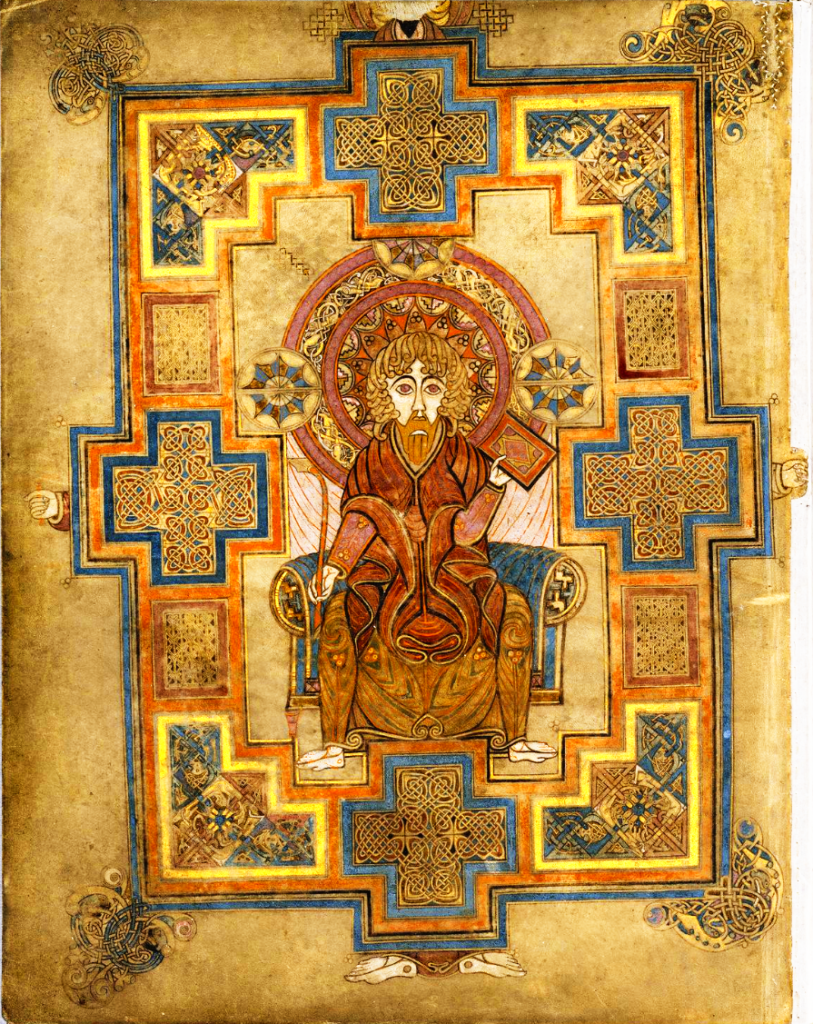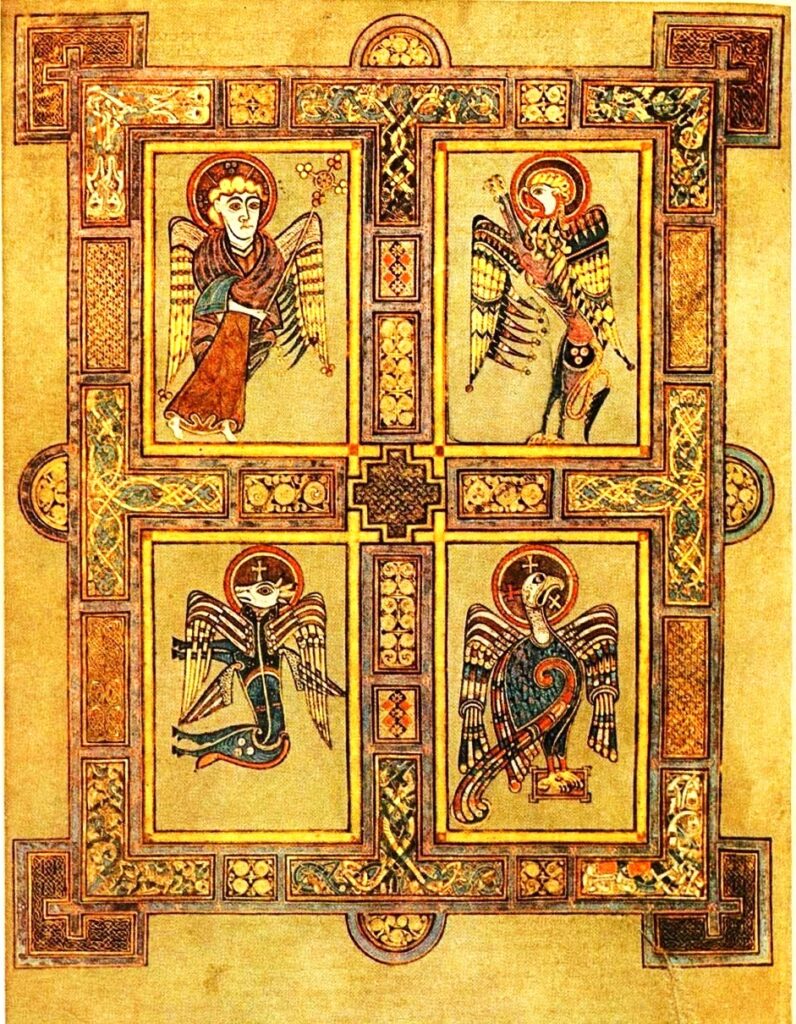The Book of Kells is:
- A magical treasure-chest of ancient writing;
- A wealth of illustrations and religious dedication;
- One of the most famous manuscripts in the world;
- One of Dublin’s most iconic tourist attractions;
- A symbol of Irish identity.
The origins of this book are shrouded in ancient mystery, but what is clear is the unique writing that sees letters and strokes forming into stunning illustrations of disciples, animals and meaningful designs – all of which represent the rich symbolism of the Gospels. On other pages, which do not include the text of the Gospels (in Latin), pages are carpeted with meaningful ornaments, designs and illustrations of certain events from Matthew, Mark, Luke and John.
What is the Book of Kells about?
The book starts with what is called the etymologies; these are basically the ancestors of Christ written down in a long family tree. Next comes the concordance. A concordance explains where a passage in one of the Gospels corresponds with the same event or passage in another of the Gospels. Next come the four Gospels – they are interspersed with pictures of important events in the life of Jesus Christ. These illustrations provide colour and visual stimulation to make the messages contained in the book so much more powerful – they really help to bring the book to life.
Who wrote the Book of Kells?
The Book of Kells was written by monks. At the time the Book of Kells was written, monks would have been a group of men who lived in isolated communities where they would dedicate their lives to worship and self-denial. However, as an outlet for their belief and artistic talents some would choose to practise and master the art of calligraphy and manuscript-making. It just so happens that around 800AD a group of outstandingly talented men were to combine their talents to create one book: The Book of Kells.
Where was the Book of Kells written?
This question is open to debate. At the time of writing, the order of monks that wrote the book had two abbeys: one in the island of Iona off the west coast of Scotland; and one in Kells, County Meath, Ireland. At this time, Ireland had a flourishing culture and society that was ahead of their counterparts on the British mainland. This was reflected in several religious communities dotted around what is now the UK, which were founded by Irish monasteries and monks. Iona was one of these, and the book may have been written, or partly written, on this small Scottish island. The town of Kells after which the book takes its name is located in County Meath, in the Republic of Ireland. Kells was chosen as the site to found a new abbey after a Viking raid on Iona meant the monks needed to set up a new site that would be protected, due to its distance from the coast and the sea-faring Viking marauders. The book may have been written in Kells and this is the name that appears in the first historical records of the book.
Why was the Book of Kells written?
Perhaps the visitation of vicious Vikings in Iona provided enough motivation for its peaceful resident monks to create this inspirational book as a means of solidifying their faith and disseminating it far & wide such that one day it might come to reform the ways of the Vikings and their ilk?
Put simply, the Book of Kells was written as an extremely comprehensive yet uniquely digestible reference aid for studying the word of God, according to traditional Christian beliefs.
Some would say it also serves to glorify the word of God, as the men who wrote the book used their artistic skills and flourishes to provide a fascinating interpretation of the Gospels that they dedicated their lives to promoting and beautifying. It is believed that the book may have furnished and coloured the altars of one of their chapels on the site of the monastery at Kells.
Why is the Book of Kells in Dublin and not in Kells of County Meath?
The monastery’s glory years had faded by the mid 17th Century. When Cromwell concentrated England’s rule in the rest of Ireland from its base in the Pale (the area around Dublin) the church that held the Book of Kells was left to ruin, therefore the book was sent to Trinity College for safekeeping. The Book of Kells has lived in the Long Room – part of the Old Library – at Trinity College since 1661.
Being 1200 years old, has the Book of Kells ever been lost or damaged?
Some parts are lost to us forever. For example, there are no portraits of Luke or Mark preceding their gospels – the pages that they would have been drawn on are presumed lost. Certain pages are also damaged. It states in the Annals of Ulster that the Book of Kells was stolen in 1007 from the church in Kells. The book was only found, hidden beneath some earth, after two months and twenty nights of frantic searching.
What are the illustrations in the Book of Kells?
There are two types of illustrations in the Book of Kells. On the pages with text the illustrations form the first letter of important New Testament verses. These beautiful swirling letters enrich – and through symbolism, reflect – the written word. The other type of illustrations are portraits or pages carpeted with beautiful Celtic plaits upon Celtic crosses, plus drawings of the most important scenes in the New Testament.
Thus, there are two types of illustrations: those which form part of the text, and those which contribute visually to the quality and depth of the text without forming part of it.
Which people and animals are drawn in the book?
The men and women represented in the beautiful drawings of the Book of Kells include:
- Jesus;
- The four Evangelists (Matthew, Mark, Luke and John);
- The 12 disciples;
- Various angels;
- And, representing the fairer sex, Jesus’s mother Mary.
All the human characters and the heavenly angels have fine blonde locks and striking eyes.

What symbolism is there in the Book of Kells?
There were four full pages in the book dedicated to the Four Evangelists (Matthew, Mark, Luke, and John). A portrait of each Evangelist precedes his respective Gospel, so before Matthew’s testament comes a portrait of Matthew, and before John’s is a portrait of John. The portraits of the other two Evengelists were lost or discarded due to damage during one of the many re-bindings of the book that have been necessary during the 1200 years of the book’s history. The Four Evangelists also appear symbolised by three animals and a human: the man (Matthew); the Lion (Mark); the Eagle (John) and the Ox (Luke). The Man represents Matthew and the birth of Christ – the period before he was one with God and therefore just a man. The Lion represents Mark and the triumphant Jesus. The Eagle represents John and Christ’s divine nature; a nature that is at one with a higher world and the earth. The Ox, an animal of work and sacrifice, represents Christ’s passion and service for mankind and the Evangelist Luke.

Peacocks also make a regular appearance in the Book of Kells. Many years before the book was written, St Augustine of Hippo compared the Peacock with Christ because Peacocks have very tough meat and do not rot quickly. He saved the breast of a peacock that he ate and found that after three days this part of the animal’s body had not become rotten and did not give off much of an odour. Therefore the peacock came to symbolise Jesus’s power to overcome and not be beaten by death.
What was the Book of Kells written on?
The Book of Kells was written on a material called Vellum, which was made from the skin of animal calves. It is calculated that 185 calves were used in the process of making the book. That this number of animals that are usually eaten, were used to make a book shows the prosperity of the monastic orders of Iona and Kells at this time. The skin was removed from the dead animal, then dried, before being treated and cleaned.
Where did the scribes get the colours from?
Most of the textual pages were written with a brownish ink, made from crushed oak apples and sulphate of iron. The blacks were made from lamp soot. The blues were made from a plant called Lapus Lazuli, imported from Italy, which again shows the prosperity of the abbeys at this time. Purples also came from the Mediterranean.